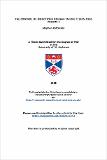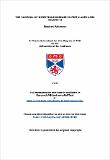Files in this item
The control of infectious diseases in Fife, c. 1855-1950
Item metadata
| dc.contributor.advisor | Smout, T. C. (T. Christopher) | |
| dc.contributor.author | Patterson, Stephen | |
| dc.coverage.spatial | 598 | en_US |
| dc.date.accessioned | 2012-06-12T15:18:27Z | |
| dc.date.available | 2012-06-12T15:18:27Z | |
| dc.date.issued | 1989 | |
| dc.identifier.uri | https://hdl.handle.net/10023/2753 | |
| dc.description.abstract | This thesis is a study-of the contribution of public health administration to the control of Infectious diseases in Fife during the period c. 1855-1950. It is a local study in the social history of medicine which attempts to test the conflicting theories of Thomas McKeown and Simon Szreter about the role of social intervention in mortality decline during the period. It covers the period from the earliest date when civil registration data on mortality from specified causes are available for Fife. During this period mortality from the main infectious diseases in the county declined almost continuously and by 88% from a rate of 608 deaths per 100 000 inhabitants during the years 1855-60. Public health administration is here defined as measures for disease prevention and control administered by local government. Such measures include the provision of adequate water supplies and drainage, improvement of housing, port sanitation, immunisation and the provision of infectious diseases hospitals and child welfare services. The first three chapters of this study include an introduction, a description of the geographical, demographic and economic conditions in Fife during the period and a description of the development of a system of public health administration in the county. This is followed by studies of the main infectious diseases, including smallpox, typhus and typhoid, diarrhoeal disease, diphtheria, scarlet fever, measles and whooping cough, influenza and all forms of tuberculosis. The pattern of mortality from each disease in Fife is described. Then from the records of local authorities in the county, the role of public health administration in the attempted control of each disease is described and evaluated. The conclusion assesses the overall contribution of public health administration to the decline in mortality from the main infectious diseases in Fife and suggests the relative importance of different measures in the process of disease control. | en_US |
| dc.language.iso | en | en_US |
| dc.publisher | University of St Andrews | |
| dc.subject.lcc | RA643.7S3F5P2 | |
| dc.subject.lcsh | Communicable diseases--Fife--History | en_US |
| dc.title | The control of infectious diseases in Fife, c. 1855-1950 | en_US |
| dc.type | Thesis | en_US |
| dc.type.qualificationlevel | Doctoral | en_US |
| dc.type.qualificationname | PhD Doctor of Philosophy | en_US |
| dc.publisher.institution | The University of St Andrews | en_US |
This item appears in the following Collection(s)
Items in the St Andrews Research Repository are protected by copyright, with all rights reserved, unless otherwise indicated.


